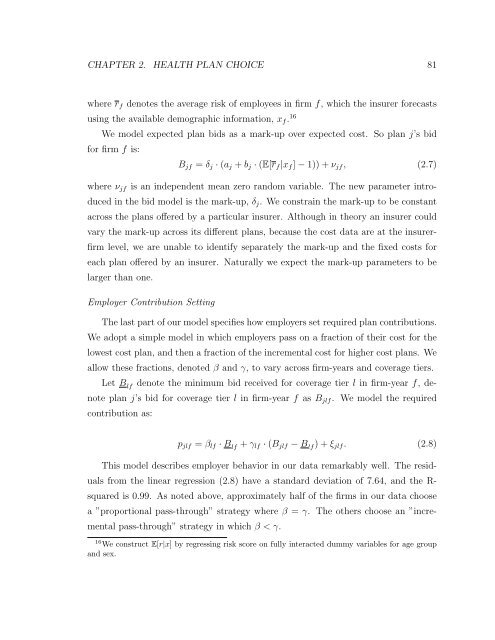essays in public finance and industrial organization a dissertation ...
essays in public finance and industrial organization a dissertation ...
essays in public finance and industrial organization a dissertation ...
You also want an ePaper? Increase the reach of your titles
YUMPU automatically turns print PDFs into web optimized ePapers that Google loves.
CHAPTER 2. HEALTH PLAN CHOICE 81<br />
where rf denotes the average risk of employees <strong>in</strong> firm f, which the <strong>in</strong>surer forecasts<br />
us<strong>in</strong>g the available demographic <strong>in</strong>formation, xf. 16<br />
We model expected plan bids as a mark-up over expected cost. So plan j’s bid<br />
for firm f is:<br />
Bjf = δj · (aj + bj · (E[rf|xf] − 1)) + νjf, (2.7)<br />
where νjf is an <strong>in</strong>dependent mean zero r<strong>and</strong>om variable. The new parameter <strong>in</strong>tro-<br />
duced <strong>in</strong> the bid model is the mark-up, δj. We constra<strong>in</strong> the mark-up to be constant<br />
across the plans offered by a particular <strong>in</strong>surer. Although <strong>in</strong> theory an <strong>in</strong>surer could<br />
vary the mark-up across its different plans, because the cost data are at the <strong>in</strong>surer-<br />
firm level, we are unable to identify separately the mark-up <strong>and</strong> the fixed costs for<br />
each plan offered by an <strong>in</strong>surer. Naturally we expect the mark-up parameters to be<br />
larger than one.<br />
Employer Contribution Sett<strong>in</strong>g<br />
The last part of our model specifies how employers set required plan contributions.<br />
We adopt a simple model <strong>in</strong> which employers pass on a fraction of their cost for the<br />
lowest cost plan, <strong>and</strong> then a fraction of the <strong>in</strong>cremental cost for higher cost plans. We<br />
allow these fractions, denoted β <strong>and</strong> γ, to vary across firm-years <strong>and</strong> coverage tiers.<br />
Let B lf denote the m<strong>in</strong>imum bid received for coverage tier l <strong>in</strong> firm-year f, de-<br />
note plan j’s bid for coverage tier l <strong>in</strong> firm-year f as Bjlf. We model the required<br />
contribution as:<br />
pjlf = βlf · B lf + γlf · (Bjlf − B lf)+ξjlf. (2.8)<br />
This model describes employer behavior <strong>in</strong> our data remarkably well. The resid-<br />
uals from the l<strong>in</strong>ear regression (2.8) have a st<strong>and</strong>ard deviation of 7.64, <strong>and</strong> the R-<br />
squared is 0.99. As noted above, approximately half of the firms <strong>in</strong> our data choose<br />
a ”proportional pass-through” strategy where β = γ. The others choose an ”<strong>in</strong>cre-<br />
mental pass-through” strategy <strong>in</strong> which β










